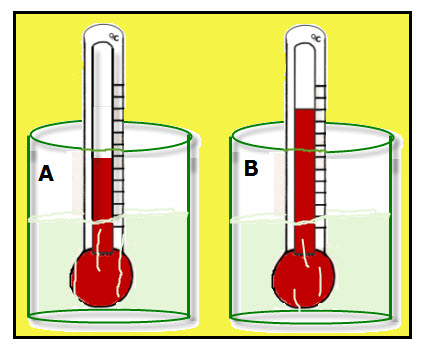Temperature measures how hot or cold a material is.
Hot materials have a higher temperature than cold
materials.
In the Diagram:
The contents of container A has a lower temperature than the contents of container B. I know this because the temperature reading on the thermometer in container A is lower than is the reading on the thermometer in container B.
Temperature is a measure of the average kinetic energy of all the particles in the material. Kinetic Energy (KE) is the energy of moving objects. The faster the motion of an object, the great is the kinetic energy of the object. It is important to remember that kinetic energy does not cause an object to move. Instead, because an object is in motion it has kinetic energy.
The liquid particles in the two containers are in motion. All the liquid particles in one container are not moving at the same speed. The particles that crash into the thermometer rebound but at a lower speed. This is because some of their energy is lost to the thermometer. This gained energy causes the red liquid to heat up and expand. The expanded liquid moves up the thermometer scale.
In the Diagram, which container, A or B, has:
1. the liquid with the greatest average kinetic energy? (B)
2. the liquid with the least average kinetic energy? (A)
3. a thermometer with the highest temperature reading? (B)
4. the hottest liquid? (B)
VanCleave, Janice. Weather. New York: Wiley, 1995. Experiments about temperature and other weather topics. Each chapter contains ideas that can be turned into award-winning science fair projects.

